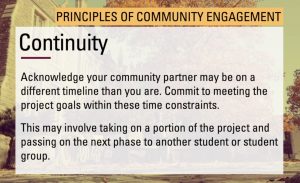Chapter 10: Continuity

As with any new relationship, there is a lot of uncertainty early on.Continuity is important in developing and sustaining community partner relationships. To create continuity in the long term, it is important to set the stage by motivating the relationship and committing to one another. This can be difficult. As with any new relationship, there is a lot of uncertainty early on. Explicitly and regularly discussing expectations for all partners is a great way to provide assurance to all parties that this relationship is worth the investment of time and energy.
Actively discussing and working together to establish plans for the long term could enhance the relationship.Working towards establishing continuity in the long term is also a relevant factor to consider. All stakeholders may be less inclined to invest in a partnership if the efforts, time and work are perceived as only short-term unless otherwise agreed upon.
Actively discussing and working together to establish plans for the long term could enhance the relationship, especially if there are anticipated personnel changes.
Zizheng talks about his experiences with Continuity in this short video clip (access to closed captions in the toolbar):
Watch the whole 27-minute video, “The Principles of Community Engagement Module” [27:38].
Case Scenario: Continuity
A student is part of a club that has partnered with a local school and the student volunteers with a Grade 6 class as part of an after-school STEM program during the 8 months of the university academic year. As March approaches, the club has decided to continue the initiative the following year but is uncertain as to who might be the specific student volunteer assigned to that particular school.
- What would be important for the current student volunteer to provide to the involved personnel at the local school prior to their last day of volunteering?
- Why might this information be important to share?
- What would the continuation of the volunteer role contribute to the relationship of the community partner?
- The club has decided to continue the role; however, who else needs to be a part of this discussion?
Checklist: Continuity
Here are some questions you might ask yourself when considering the principle of continuity in your community engaged learning experience:
- Are there opportunities to build on prior community-engaged learning with this community partner? What are they?
- Are there opportunities to develop future community-engaged opportunities with this partner? What are they?

